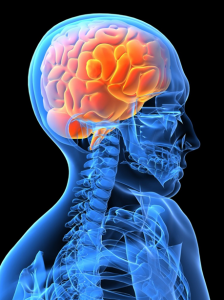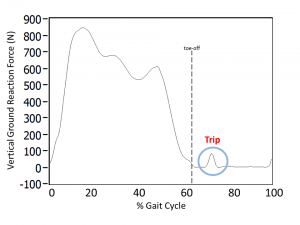Biomechanical gait characteristics of unsuccessful foot clearance during swing in individuals with chronic stroke
Jessica Burpee, SPT
Overview
Stroke is a leading cause of motor impairment and disability as many individuals demonstrate one-sided weakness (hemiparesis) following stroke.1 Individuals with lower extremity hemiparesis secondary to chronic stroke commonly demonstrate altered biomechanical characteristics of gait.2,3 These abnormalities can be contributory to decreased foot clearance and trips leading to an increased risk for falls and injury during ambulation.4 Due to the increased risk for falls during ambulatory activities, improvement of walking ability is a primary goal in stroke rehabilitation.5 However, in order to design effective intervention strategies for the rehabilitation of ambulatory function, the mechanisms underlying hemiparetic gait deviations must be understood. The aim of my Capstone Project was to analyze and synthesize the results of the research I conducted on the biomechanics of trips during hemiparetic gait to write a manuscript which will be submitted for publication.
Research
Throughout my time in PT school I have had a strong interest in neurological rehabilitation, particularly in the post-stroke population. Prior to the start of my third year in the DPT program, I met with Mike Lewek, PT, PhD to discuss taking part in a research project in his lab which specializes in the biomechanical and neurophysiological aspects of gait following stroke. Together we decided upon a research project that would examine the biomechanical parameters underlying unsuccessful foot clearance (i.e. trips) during hemiparetic gait. Alterations in gait biomechanics, including spatiotemporal, kinematic, and kinetic characteristics, have been previously described in individuals with chronic stroke.6,7 However, this literature primarily focuses on the comparison of the paretic limb to the non-paretic limb or to unimpaired control subjects.8 In my review of the literature, I found no current studies that have examined the biomechanical characteristics of trips in the paretic limb during the swing phase of gait.
Under the advisement of Mike Lewek I completed a research elective in the fall of 2013 analyzing biomechanical data collected from subjects with gait abnormalities secondary to chronic stroke. I drafted, submitted, and had approved an IRB for the research that I would be conducting, I learned to independently navigate gait analysis software (e.g., Vicon Nexus and Visual3D), I gained an understanding of gait analysis data (e.g., lower extremity kinematics and joint kinetics), and I was able to collect and analyze relevant biomechanical data points. By the end of the semester I had completed a retrospective analysis of 26 individuals with chronic stroke and measured the spatiotemporal parameters and lower extremity kinematics and kinetics associated with trips during ambulation.
Manuscript
In February I presented the results of my research at the Human Movement Science Research Symposium at UNC under the category of Performance and Movement Analysis. I created an oral presentation and PowerPoint which I presented to an audience of faculty and students from 5 North Carolina universities. Preparation of this presentation provided an outline for my first draft of the manuscript. I was required to organize an introduction to the problem, be able to describe the methods used, explain the results, and interpret the results in a succinct discussion.
Throughout the manuscript writing process I worked closely with Mike Lewek who consistently provided me with guidance and feedback regarding the organization and formulation of each component of the paper. I dove deep into literature dealing with everything from the circumstances and consequences of falls following stroke to the lower extremity kinematics and kinetics of each phase of gait. The final product is a completed manuscript that will be submitted for publication to a scientific journal. If published, this research will supplement the current lack of literature on the biomechanics of trips during ambulation in individuals with chronic stroke. It is my hope that understanding and assessing the biomechanics of trips will guide interventions and therapies that may help prevent falls and falls-related injuries in the post-stroke population.
Acknowledgements
I would like to specially thank Mike Lewek for his knowledge, support, and guidance throughout the entire research and writing process. He is an exceptional adviser, an invaluable teacher, and encouraging mentor. I would also like to thank Prue Plummer, PhD for being a committee member on this project and providing feedback on the manuscript.
References
1. Cauraugh JH, Kim SB. Chronic stroke motor recovery: Duration of active neuromuscular stimulation. J Neurol Sci. 2003;215(1–2):13-19.
2. Bohannon RW. Gait performance of hemiparetic stroke patients: Selected variables. Arch Phys Med Rehabil. 1987;68(11):777-781.
3. Bourbonnais D, Vanden Noven S, Pelletier R. Incoordination in patients with hemiparesis. Can J Public Health. 1992;83 Suppl 2:S58-63.
4. Forster A, Young J. Incidence and consequences of falls due to stroke: A systematic inquiry. BMJ. 1995;311(6997):83-86.
5. Perry J, Garrett M, Gronley JK, Mulroy SJ. Classification of walking handicap in the stroke population. Stroke. 1995;26(6):982-989.
6. De Quervain I, Simon SR, Leurgans S, Pease W, McAllister D. Gait pattern in the early recovery period after stroke*. The Journal of Bone & Joint Surgery. 1996;78(10):1506-1514.
7. Mulroy S, Gronley J, Weiss W, Newsam C, Perry J. Use of cluster analysis for gait pattern classification of patients in the early and late recovery phases following stroke. Gait Posture. 2003;18(1):114-125.
8. Olney SJ, Richards C. Hemiparetic gait following stroke. part I: Characteristics. Gait Posture. 1996;4(2):136-148.



3 Responses to “Biomechanical gait characteristics of unsuccessful foot clearance during swing in individuals with chronic stroke”
Michael Tighe
Dear Jessica:
I very much enjoyed your capstone project. What a great honor, to be able to present your findings to an audience from so many different colleges! I’m sure it was an exciting, exhilarating experience!
I loved your description of the end-result of impaired dorsiflexion and knee flexion as lengthening of the hemiparetic leg during swing phase. I use a similar description, and see a similar presentation, teaching car transfers to patients, when it is often markedly easier to see the results of that lengthening (catching their foot on the doorframe, for example) than during real-time gait observation. How interesting that such a small change in plantarflexion (1.1 deg) is associated with such a large increase in incidence of trip!
It was also interesting to me how you described AFO use being prescribed to address toe drag during swing phase. In our clinical practice, we most often use AFOs to improve stability in the paretic leg during stance phase versus to treat swing phase issues.
Where do things stand in the publishing process, and when do you find out if and when your article has been selected for publication?
Michael Tighe
Michael Lewek
Jessica
You really did an outstanding job on this. But I think your description of what you did is not entirely accurate. You stated that you analyzed 26 people… it was more like 40 (to find the 26 individuals that you needed). Likewise, you stated that you presented at HMSC day to individuals from 5 Universities (it was definitely more than that). I am very impressed with the work that you did… in particular, your ability to read, understand, and synthesize the literature in a meaningful way. I continue to think that you would be an outstanding PhD student, whether it is here or elsewhere.
Prue has provided you with some excellent suggestions for improving the manuscript and I look forward to getting this out in the literature.
Very, very well done job!!!
Mike
Abby Osborn
Burpee,
Dude! I am so impressed with all that you have accomplished this year, you have put a tremendous amount of work into this project! It looks awesome! And I can’t (but do) believe that paretic limb, swing phase trips have not been evaluated in the past…I’m no expert but to me it seems like this is where the majority of trips would occur, which is quite clinically relevant. And I was interested to read about the multiple joint changes contributing to falls, rather than the focus on ankle joint that dominates clinical practice. Very cool findings! And very proud of you!
Good work,
Abby